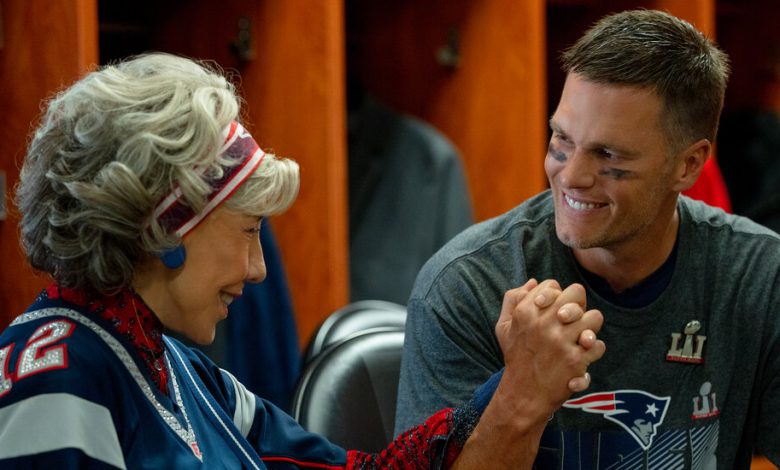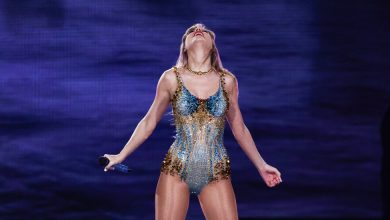When Athletes Go Hollywood

When is a famous athlete not a famous athlete? When they’re appearing as themselves in a Hollywood movie — then they’re a movie star. Or are they? Despite more than a century of sports legends appearing in films, very few have brought the stardust of their exploits on the field to the very different arena of the big screen. The latest to try is the football godhead Tom Brady.
Not only does the ex-New England Patriot/current Tampa Bay Buccaneer (who recently announced his retirement) appear as himself in the new comedy “80 For Brady,” but the mythos surrounding him forms the basis of the plot, with four senior Patriots fans — played by Jane Fonda, Lily Tomlin, Rita Moreno and Sally Field — road-tripping to the 2017 Super Bowl in Houston. Brady appears in the final scenes, getting pep-talked by Tomlin’s character, and let’s just say that he should probably hold onto his day job. But audiences aren’t really expecting the 45-year-old quarterback to suddenly reveal his inner Christian Bale. They just want — well, what do they want? What’s the appeal of a jock out of water?
The movies have been wrestling with this conundrum from the start, when Thomas Edison filmed an 1894 match between the boxers Mike Leonard and Jack Cushing and sold it to the public on Kinetoscope at 10 cents a round. The silent era, once it got going, was a heyday for sports stars onscreen, both since it gave audiences a chance to see their heroes up close, and because the lack of dialogue obviated any need for trained acting.
The Detroit Tigers slugger Ty Cobb appeared in a 1917 drama called “Somewhere in Georgia,” now lost, that cast him as a baseball-playing bank clerk who rescues his girl from kidnappers and wins the big game. The Bambino himself, Babe Ruth of the New York Yankees, starred as a fictionalized small-town Babe in the 1920 film “Headin’ Home.” Available on YouTube, that century-old film is amusingly of its time and Ruth is an amiably persuasive screen presence — a movie star.
With the coming of sound in the mid-1920s, athletes reverted to being found objects onscreen, making cameos and called upon to speak one or two lines to show that they were, in fact, human. Even those Olympians who carved out bona fide screen careers — the swimmers Johnny Weissmuller (“Tarzan”) and Esther Williams, the skater Sonja Henie — weren’t taken seriously as actors. More typical was the 1952 Spencer Tracy-Katherine Hepburn comedy “Pat and Mike,” which brought on a raft of real-life names to give its sports-centric story line background credibility: the tennis stars Gussie Moran and Don Budge; the golfers Babe Didrikson Zaharias and Helen Dettweiler. None of them were called upon to do any dialogue heavy lifting.
The exception here is “The Jackie Robinson Story,” a 1950 feature that cast the Brooklyn Dodger as himself in a dramatically softened version of how he broke the color barrier in professional baseball. Robinson is clearly an amateur actor but is believable even in fictionalized romantic scenes involving his co-star, a very young Ruby Dee. The performance is really the first to tease out a fundamental difference between two types of stardom — sports and film — that continues to play out on screens today when players like Brady ascend the stage.
The difference lies in the minds and expectations of spectators, and it’s the difference between endeavor and imposture. Simply put, we love to watch athletes do and we love to watch actors be. When actors play sports stars — Will Smith as Muhammad Ali (“Ali,” 2001), Gary Cooper as Lou Gehrig (“The Pride of the Yankees,” 1942), Saniyya Sidney and Demi Singleton as Venus and Serena Williams (“King Richard,” 2021) — we appreciate the skill and charisma of the performance and we buy in for the duration of the show, but we know it’s not the real thing. With star athletes, “the real thing” is paramount — the knowledge that their accomplishments are happening in actual time and space and thanks to finely-honed reflexes. An acting performance is a product of thought, but if an athlete thinks too hard about what they do, it can give them the yips.
In a sense, then, asking a sports legend to deliver a convincing movie performance is like asking a horse to moo. The surprise is that some can do it at all. Back to the timeline: With the breakdown of the studio star system in the 1960s and the coming of the civil rights era, athlete involvement in films began to change. Figures previously considered outsiders now had an in: The Cleveland Browns running back Jim Brown was having so much fun shooting “The Dirty Dozen” in 1966 that when the Browns owner Art Modell told him to report back to practice, Brown announced his retirement from football.
An above-the-title action star by the late 1960s, Brown had a taboo-busting interracial sex scene with Raquel Welch in “100 Rifles” (1969), and he paved the way for other N.F.L. emigrants like Rosey Grier, O.J. Simpson, the blaxploitation star Fred Williamson, Joe Namath, and Alex Karras of the Detroit Lions, who rose from playing Mongo in “Blazing Saddles” (1974) to starring in his own successful 1980s sitcom (“Webster”).
Many of these athlete-actors weren’t playing themselves — and yet, in a sense, they were: The hoops star Kareem Abdul-Jabbar was cast as a co-pilot in the madcap comedy “Airplane!” (1980), but the joke was that no one else in the movie pretended he was anyone but Kareem Abdul-Jabbar. The award for juggling identities probably goes to Muhammad Ali, who played himself in his own 1977 biopic, “The Greatest,” and two years later played a slave-turned-U.S. senator in the historical TV drama “Freedom Road.” Neither performance was award-worthy in the traditional sense, yet both are engaging and assured — exactly what you’d expect from a man who’d long since proved himself a genius at creating a persona. Ali was an actor from the get-go, and his talent was much bigger than the boxing ring.
It’s in his mold that today’s sports stars work their mojo onscreen, tacking between appearing as themselves and more serio-comic versions of themselves in films, commercials and on “Saturday Night Live.” Given the business branding now built into pro sports and the endless close-ups of cable news and social media, an athlete with any measure of renown develops a persona — a public version of who they are — or has it developed for them by a management team or, more dangerously, by the public.
As a result, filmed performances are more nuanced, more self-aware — more professional: Michael Jordan as a live-action cartoon among the Warner Bros. menagerie in “Space Jam” (1996), Lawrence Taylor doling out steam room advice to Jamie Foxx in “Any Given Sunday” (1999), Mike Tyson playing a comically scary version of his scary self in “The Hangover” (2009). Two more recent high-water marks of N.B.A. thespianism are LeBron James’s thoroughly charming supporting turn in the 2015 Amy Schumer romantic comedy “Trainwreck” and Kevin Garnett’s appearance in the Safdie brothers’ gritty drama “Uncut Gems” (2019) — basketball players “playing themselves” while bringing a subtle understanding of what that means on the stage of modern fame.
Indeed, the line between professional sports and professional entertainers may finally be said to have been obliterated when an M.M.A. fighter like Gina Carano can land a lead in a Steven Soderbergh movie (“Haywire,” 2011) and the cartoon theater of professional wrestling can give us pop culture’s biggest movie star of the moment, Dwayne Johnson, a.k.a. The Rock. Next to them, Tom Brady in “80 for Brady” is a throwback to an earlier and gentler day, when athletes excelled at playing — and not so much at playing themselves.




